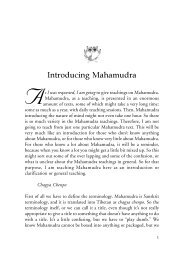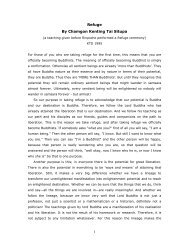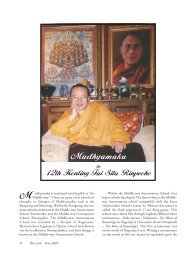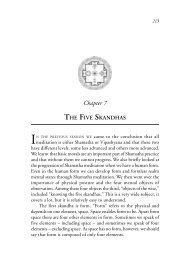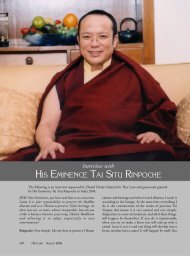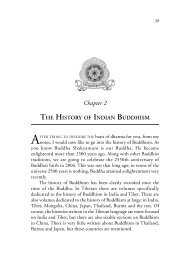The Nature of Mind - Zhyisil Chokyi Ghatsal
The Nature of Mind - Zhyisil Chokyi Ghatsal
The Nature of Mind - Zhyisil Chokyi Ghatsal
Create successful ePaper yourself
Turn your PDF publications into a flip-book with our unique Google optimized e-Paper software.
<strong>The</strong> <strong>Nature</strong> <strong>of</strong> <strong>Mind</strong><br />
By<br />
Chamgon Kenting Tai Situpa<br />
Part 1:<br />
Defilements as Wisdom<br />
I have been asked to give an introduction to the nature <strong>of</strong> mind. ‘<strong>Nature</strong> <strong>of</strong> mind’, in<br />
one way or another, covers everything; otherwise, we wouldn’t be here. You have all<br />
come up here, driven a long way, or walked, and have come into this room thinking<br />
you would be hearing some explanations about the dharma. In a way, we have<br />
already introduced ourselves to the mind. It is something obvious, perhaps too<br />
obvious. Still, we want to learn something about it.<br />
I don’t think I will ever have the chance to see my own face directly. But I have<br />
seen a photograph <strong>of</strong> it. I have seen it in the mirror, as a reflection, but then always<br />
I have seen it with right and left reversed! <strong>The</strong> same thing will happen to us when<br />
we talk about the nature <strong>of</strong> mind. If we talk about it for years, we will be more<br />
familiar with it; we will have an intellectual understanding about it. This intellectual<br />
understanding will be helpful, certainly, but it won’t be totally accurate—no way. Yet,<br />
if we say something about it, it won’t be a waste <strong>of</strong> words; if we think about it, it<br />
won’t be a waste <strong>of</strong> thought; if we do something about it, it won’t be a waste <strong>of</strong><br />
action.<br />
<strong>The</strong>re is a simple verse in the Mahamudra Prayer, which says in Tibetan:<br />
CHHÖ NAM T’HAM CHE SEM KYI NAM T’HRUL TE<br />
SEM NI SEM ME SEM KYI NGO WO TONG<br />
TONG SHING MA GAG CHIR YANG NANG WA TE<br />
LEK PAR TAK NE SHI TSA CHHÖ PAR SHOK.<br />
<strong>The</strong> first line says, “Everything is a manifestation <strong>of</strong> mind.” Here, ‘everything’ means<br />
what you see, what you hear, what you touch, what you smell, what you feel—<br />
everything that is out there—as well as the one who hears it, who touches it, who<br />
smells it, and so forth—everything in here. ‘Everything’ covers all <strong>of</strong> it.<br />
1
<strong>The</strong> second line says, “This mind is beyond any solid identity,” which is quite<br />
true. For example, if we stand in the middle <strong>of</strong> the street, we will be quite disturbed,<br />
because there is chance that a huge truck, maybe an 18-wheeler, might run over us,<br />
and we’d be flat on the street, maybe stretched out for one hundred meters. That’s<br />
not funny, you know; it’s serious. That chance is there, so we will certainly feel<br />
disturbed.<br />
Or, we might just sit under a tree in a beautiful serene place such as here in<br />
Woodstock, a place famous all over the world. Sitting here, you can feel serenity,<br />
peacefulness, and a kind <strong>of</strong> freedom within yourself. In either case, you will feel that<br />
the mind is there, it is real, it is not a game. But at the core <strong>of</strong> it, the heart <strong>of</strong> it, you<br />
cannot grasp it, you cannot box it in, you cannot pin it down, you cannot point to it—<br />
that is what the author means by the second sentence in the prayer.<br />
So, the mind is beyond any solid identity. <strong>The</strong>n the third line says, “Yet<br />
everything continuously appears from it.” This means there is nonexistence, but at<br />
the same time, not just nothingness. <strong>The</strong> mind has two sides, like a coin. On one<br />
side is nonexistence, emptiness, and on the other side, it’s not totally empty—it is<br />
there. It is the king, the master, the source from which everything manifests. So<br />
that is the character, the personality, the image <strong>of</strong> the mind.<br />
<strong>The</strong> last sentence says, “May we realize with confidence this potential through<br />
contemplation.” Now, all people go through different experiences in life. Some people<br />
go through a lot <strong>of</strong> confusion and all kinds <strong>of</strong> delusion. <strong>The</strong>ir life process is filled with<br />
harshness and chaos, and they must manage somehow to survive. Other people, the<br />
so-called lucky ones, have comfort and positive circumstances. For them, everything<br />
falls into the right order and everything seems to go quite smoothly. All <strong>of</strong> these<br />
different aspects <strong>of</strong> life’s journey lead to one goal. <strong>The</strong> purpose <strong>of</strong> the existence <strong>of</strong> all<br />
sentient beings is to awaken. That is the final destination. Until we awaken<br />
individually, we will go on; we cannot stop—not in any way. Even if you try to escape<br />
this planet, maybe go to another planet, you will still have to go through the same<br />
old trip; maybe worse, maybe better, but still the same thing.<br />
Thus the final thing for us to do is to awaken this nature, to awaken this potential<br />
that is within us. If we try to put an image to it, we might say it shines within us like<br />
a lamp inside a house. If we put in a window, a little bit <strong>of</strong> light may come out; if we<br />
put in a door, maybe more light will come out. If the whole house is made <strong>of</strong> glass,<br />
the entire light might come out, and if there is a mirror behind the light, it will<br />
expand even more.<br />
2
That is an explanation about the nature <strong>of</strong> mind that comes from a Mahamudra<br />
text, and it says a lot to me. It is a short, four-line message that describes, roughly,<br />
everything about mind—this mind which is pure, which is clear, which is beyond<br />
existence and nonexistence. At the moment, however, the relative manifestation <strong>of</strong><br />
the mind, the relative character <strong>of</strong> the mind, is what we’re directly involved with, and<br />
it is through this relative character <strong>of</strong> the mind that we relate to the potential within<br />
us. I have heard that Khenpo Karthar Rinpoche’s favorite subject is ‘<strong>The</strong> nature <strong>of</strong><br />
defilements as wisdom, and the nature <strong>of</strong> samsara as nirvana’. Isn’t that beautiful? I<br />
like that, I must say I like that.<br />
How can defilements exist? We can use the word defilement or kleshas, but what<br />
it really means is desire, anger, jealousy, and pride—all these emotions that are<br />
within us. <strong>The</strong>y are called defilements because they somehow prevent us from<br />
seeing our ultimate nature. It is quite simple. <strong>The</strong> way we relate to something causes<br />
us to have desire for it, to have anger about it, jealousy about it, pride about it, and<br />
all these things are interrelated.<br />
I would like to share something with you. In 1984, I went to Tibet and visited<br />
certain places high up in the mountains. From the nearest airport I had to drive four<br />
days by jeep—can you imagine driving on a dirt road for four days? After that, it was<br />
almost two days more on horseback. And this was in December. I’m thankful for<br />
being healthy. If I had been sick I might have been stranded up there for months,<br />
and there are no hospitals. Up there I met some nomadic people who, <strong>of</strong> course,<br />
have their own defilements, which are quite different from ours. For them, cars,<br />
fashion, credit cards, the stock exchange, <strong>The</strong> Wall Street Journal, the world news—<br />
those things don’t mean anything; they simply don’t exist for them. Nothing,<br />
absolutely nothing, exists in their heads about those things. For us though, because<br />
<strong>of</strong> our circumstances, our conditioning, our habits, the way we are introduced to<br />
these things, they mean everything. If we own stock in a company and that stock<br />
goes down, we can’t go to sleep at night. For us it is very real, it is not a game. But<br />
in Tibet, they have their own different reality.<br />
Thinking about that gave me a clear picture. Before that, when I was small, I<br />
used to watch rock music stars on television and I used to think that they were<br />
great. But when I came back from Tibet and I went to the United States and I turned<br />
on MTV, I couldn’t believe what I saw, and I thought, “How can I say this is great?”<br />
It is just like a dramatization <strong>of</strong> hell—people make faces, people scream and jump<br />
3
around like mad. I’m not saying that it’s bad, but after being in Tibet for four<br />
months, the influence <strong>of</strong> that culture changed my perception.<br />
<strong>The</strong> Tibetan way <strong>of</strong> beauty and expression is very different from our way, and<br />
their way <strong>of</strong> relating to things, their sort <strong>of</strong> thrill is very different from ours. This was<br />
something very subtle, but was a kind <strong>of</strong> revelation to me. It shows that in any<br />
culture or any sort <strong>of</strong> environment, we go through all sorts <strong>of</strong> interrelated<br />
encouragements for our own defilements. I knew all <strong>of</strong> this before 1984, but this trip<br />
made it very clear to me. One more step, I guess.<br />
And definitely it is okay to have defilements, it is not a terrible thing, but we<br />
have to be able to deal with them properly. It is not that we are not allowed to have<br />
defilements, or that they are totally bad or negative.<br />
<strong>The</strong>n, what does ‘the nature <strong>of</strong> defilements as wisdom’ mean? This is a very<br />
important statement. <strong>The</strong> ultimate nature <strong>of</strong> those defilements is wisdom—it has to<br />
be, otherwise what could it be? Since defilements exist, there must be another side<br />
to them—and that side is wisdom—but it is wrong to think that we just have to sit<br />
back and let everything happen. That is wrong, totally wrong. We have done that<br />
already, and see how we’ve ended up! What we must do is learn to deal with our<br />
defilements properly, and that is what dharma is all about.<br />
In Buddhism, the basis for dealing with the defilements is motivation. This<br />
motivation is supported by mindfulness and awareness, constant mindfulness and<br />
awareness in every situation <strong>of</strong> everyday life, under the umbrella <strong>of</strong> motivation. This<br />
doesn’t mean we are not allowed to rest. We can rest, but we must rest mindfully.<br />
We will have a happy rest, but we will not rest in the middle <strong>of</strong> the highway—that<br />
would not be mindful, and we might again be flattened! So, we rest with<br />
mindfulness.<br />
If we use mindfulness and awareness, then we can deal with our defilements<br />
accurately and correctly. <strong>The</strong>n, whatever defilements we have can be transformed<br />
into their ultimate nature, which is wisdom. Take anger, for example. Anger comes<br />
quite easily for people who work hard. That’s because after you work hard, you like<br />
to rest. <strong>The</strong> work pushes you, and you get a little tired and things don’t fall in<br />
order—they are a little bit early or a little bit late—and then you get disturbed, and it<br />
gets on your nerves, and that’s where the anger comes in.<br />
Now, anger is totally the opposite <strong>of</strong> compassion, isn’t it? That’s what most<br />
people think. But, let’s be sympathetic about it, try to learn more about it, and say<br />
that it is more like a two-sided coin: this side is compassion, the other side is<br />
4
anger—compassion, anger; compassion, anger. Now if you go deeper and deeper<br />
into the anger, it will lead you definitely to compassion. Until you do that it will never<br />
stop. That means the ultimate nature <strong>of</strong> anger is compassion. Now, there are<br />
hundreds <strong>of</strong> ways to deal with anger—it is all individual—but let’s give an example. If<br />
you have tremendous anger, you could try one <strong>of</strong> two options, basically, unless you<br />
are a special person. You can either get into it and smash something—it can be cups<br />
or saucers or anything—or you can say, “All right, face it and let it go.”<br />
What is the best way to let it go? Of course it depends upon the situation you are<br />
in and why you are angry, but most <strong>of</strong> the time somebody makes you angry,<br />
somebody irritates you and gets on your nerves and you get angry. One thing to do<br />
then is say to yourself, “Does this person honestly wish to make me angry?” It’s<br />
unlikely. Out <strong>of</strong> a hundred people who irritate you, maybe only one person means it.<br />
You think <strong>of</strong> that person’s circumstance, you think <strong>of</strong> that person’s reason. That<br />
person is not just doing something—there is always a reason. He or she is going<br />
through many things, and all <strong>of</strong> these circumstances together made that person get<br />
on bad terms with you.<br />
<strong>The</strong>re are so many reasons lying behind it, and if you think about them, that<br />
makes you say, “Poor fellow,” because <strong>of</strong> all those circumstances that the other<br />
person has to endure. You can see that he or she doesn’t mean to make you angry,<br />
so you can develop some sense <strong>of</strong> compassion inside you, which makes you say, “Let<br />
him be the winner,” and just let it go. <strong>The</strong>n tomorrow, you will find everything in<br />
your kitchen is fine, nothing is broken, no broken cups, no broken saucers. That is<br />
the practical way to deal with anger.<br />
Of course, we have to practice when anger is not there, so we will be able to<br />
cope with it when anger arises. Even if you are totally disturbed by anger, there is<br />
still a chance for you to overcome that emotion if you can look at the anger itself,<br />
the emotion itself, honestly. In the situation <strong>of</strong> anger, a lot <strong>of</strong> excuses and selfbrainwashing<br />
take place. When you’re angry at a person, you are aware <strong>of</strong> that<br />
person’s good part, but you always deny it. You close the curtain, you close the door<br />
and lock it, you give yourself no chance to see the good part <strong>of</strong> the person. It’s very<br />
easy for someone to get carried away by anger. When some people get angry at<br />
their best friends, they say, “I will kill you!” <strong>The</strong>y don’t mean it, but they say it. But<br />
when you look at the anger and reduce it to its reality, that is an improvement; there<br />
will be no exaggeration. You will be able to see the good part <strong>of</strong> the person as well<br />
5
as the bad part. That way it balances. Your anger is not totally gone, but you have<br />
reasonable anger, so it becomes not impossible, but possible to overcome it.<br />
As a Buddhist, another way to deal with defilements is through meditation<br />
practice. In each meditation practice we generate loving kindness, we generate<br />
compassion, and we generate impartiality. We generate these things by saying them,<br />
praying, thinking about them—and that is directly dealing with and connecting with<br />
our own selves. Who is praying? Ourselves! And when we pray we think about what<br />
we say and we mean what we say. Those, then, are ways we can transform our<br />
negative defilements into their positive, ultimate essence. <strong>The</strong>se are simply basic<br />
concepts to give you an immediate solution to any particular defilement you may<br />
encounter.<br />
To summarize: the nature <strong>of</strong> mind is the essence, the essence <strong>of</strong> each <strong>of</strong> us, the<br />
ultimate <strong>of</strong> everything. Defilements are relative manifestations <strong>of</strong> it, unfortunately;<br />
but fortunately, the essence <strong>of</strong> those defilements happens to be wisdom. <strong>The</strong> entire<br />
practice <strong>of</strong> dharma, then, is for the purpose <strong>of</strong> awakening that ultimate nature, by<br />
transforming those defilements into wisdom, and so reaching the final destination <strong>of</strong><br />
every sentient being. This is practiced with the basic motivation and method <strong>of</strong><br />
mindfulness and awareness.<br />
Part 2:<br />
Samsara as Nirvana<br />
I have discussed the nature <strong>of</strong> defilements as wisdom. That leads us to the nature <strong>of</strong><br />
samsara as being nirvana. <strong>The</strong> direct way <strong>of</strong> dealing with this subject is to introduce<br />
some <strong>of</strong> the abhidharma principles.<br />
As you know, the teachings <strong>of</strong> the Buddha were compiled into texts, and those<br />
texts are known as the Kangyur in Tibetan and as the Tripitaka in Sanskrit. <strong>The</strong><br />
Tripitaka, a term common to <strong>The</strong>ravada, Mahayana, and Vajrayana, means ‘three<br />
containers’, and a lot <strong>of</strong> scholars call it the ‘three baskets’. <strong>The</strong>se ‘three containers’<br />
are the vinaya, the sutra, and the abhidharma. <strong>The</strong> vinaya is simply about physical<br />
and verbal discipline. <strong>The</strong> sutras include stories and philosophy, and the Mahayana<br />
sutras tell about bodhisattvas, bodhichitta, and all those things.<br />
Abhidharma is a Sanskrit term; when it is translated into Tibetan, we say, chö<br />
ngönpa. ‘Chö’ means ‘dharma’—dharma here means anything that exists, anything<br />
the mind has a subject-object relationship with. That means whatever we hear,<br />
6
whatever we see, whatever we can imagine—it’s all dharma. ‘Ngönpa’ means ‘just<br />
there’, like the reality that is ‘just there.’ It is not hidden somewhere, it is not a kind<br />
<strong>of</strong> imagination; it is right there as sure as we are right here in this room.<br />
In the abhidharma, the Buddha teaches about the mind, about emotion, about<br />
reality. He explains time, solid material, and the evolution <strong>of</strong> living beings, and he<br />
also explains the kleshas—the emotions. In the abhidharma it is said that this world,<br />
this solar system, is just a little spark <strong>of</strong> the entirety <strong>of</strong> existence. One solar system<br />
makes one small spark <strong>of</strong> space, but a thousand solar systems make one circle—we<br />
call it a ‘first thousand’. A thousand <strong>of</strong> those make a thousand thousand—that makes<br />
a ‘second thousand’. <strong>The</strong> galaxy makes a ‘third thousand’, and that is one group;<br />
that is a little dot in endless space. <strong>The</strong> abhidharma says that space is endless, and<br />
this endless space is filled with universes, filled with ‘third thousands’. In that way, it<br />
immediately gives one the perspective <strong>of</strong> what is there, what we are involved with.<br />
<strong>The</strong> abhidharma says that at this level there is no up, there is no down, there is<br />
no east, west, north, or south, there is no direction. <strong>The</strong>re is direction, indeed, if we<br />
are relating with one particular planet <strong>of</strong> one particular solar system. But all <strong>of</strong> this is<br />
relative, even within the relative level. It is not only relative, but relative <strong>of</strong> relative.<br />
<strong>The</strong>se things exist as interrelated, interdependent—not for real, just<br />
interdependently. Interdependent origination is categorized into twelve ‘links’, and I<br />
am sure most <strong>of</strong> you know about those twelve links as they relate to states <strong>of</strong><br />
consciousness. But it doesn’t end there; it also relates to the outside world. <strong>The</strong><br />
principle <strong>of</strong> interdependence covers everything, in a relative sense.<br />
This interdependent origination leads to a term that is widely used: emptiness.<br />
You say, “Everything is here, (knocks on table) and I can’t go through the wall, and<br />
it hurts; it is real,” and, “If I don’t eat, I go hungry; it is not pleasant; it is real.” It is<br />
true that everything exists here, everything works here, everything matters here—<br />
but only interdependently, not for real, only interdependently. This concept <strong>of</strong><br />
interdependence, which leads to the understanding <strong>of</strong> emptiness, serves very well<br />
the concept <strong>of</strong> ‘samsara as nirvana’. Relatively, everything happens—that is<br />
interdependence—but ultimately, it is emptiness, and the two do not contradict each<br />
other.<br />
In the abhidharma, as one example, there is mention <strong>of</strong> a planet where human<br />
beings have only one leg. <strong>The</strong>y don’t walk, they jump. When people from that planet<br />
come here and see us walk, they laugh; they think it is very funny. If we were to go<br />
there and see<br />
7
them jump, that would be very funny, too.<br />
That is one way <strong>of</strong> looking at samsara as being nirvana, because relatively<br />
everything has happened, or is happening, and there is a lot that still will happen.<br />
Ultimately, however, nothing has happened, nothing is happening, and nothing will<br />
happen, and there is no contradiction here. <strong>The</strong>re is nothing secret about it; one just<br />
has to be aware <strong>of</strong> it and be introduced to this concept.<br />
Now another way <strong>of</strong> looking at samsara as being nirvana can be related to tantra<br />
or Vajrayana. This is more the destination <strong>of</strong> an individual’s evolution, which is<br />
reached not just through understanding but through experience. <strong>The</strong> relation, on a<br />
deeper level, is between everything that is here, and mind, which relatively are two<br />
things. I can be dead, but my dead body will be here when I am dead. So, there are<br />
two things in a relative sense; mind and matter. <strong>The</strong>re is a connection, but the study<br />
<strong>of</strong> it can give us only knowledge, not wisdom. <strong>The</strong> wisdom <strong>of</strong> it comes from<br />
experience.<br />
At this point, we will use some <strong>of</strong> the Vajrayana terms. In basic Vajrayana terms,<br />
you will come across the words dharmakaya, sambhogakaya, nirmanakaya—the<br />
three kayas. You also will come across another set <strong>of</strong> terms; vajra body, vajra<br />
speech, and vajra mind. All <strong>of</strong> those terms express this concept.<br />
Now, let us learn a little about the vajra body, because a body is solid—we see it.<br />
<strong>The</strong>re is this physical body, and there is the universal body; and there is one more<br />
step, the sacred body—the inner body. I think you will understand better if I say<br />
chakras and nadis. <strong>The</strong> chakras and nadis, then, are the sacred, inner body. <strong>The</strong><br />
universal body and this physical, personal body have not just a vague connection,<br />
but a direct connection; that is why there exists such knowledge as astrology, and<br />
why people can make astrological charts to show how it works. It is also very<br />
obvious why there is medicine. Why are there so many herbs and chemicals that can<br />
affect the physical body? It is because <strong>of</strong> this relation, because <strong>of</strong> this connection.<br />
<strong>The</strong> universe is our body, but bigger than our body, and the connection is there, so<br />
they have an effect.<br />
Thus the outer, universal body affects this personal, physical body. This personal,<br />
physical body lives and survives through chakras and nadis, which are a network <strong>of</strong><br />
energy channels that is directly connected with the mind. So the mind connects with<br />
the sacred body, and that connects with the physical, personal body, and that<br />
connects with the outer, universal body. <strong>The</strong> ultimate <strong>of</strong> these bodies—the universal,<br />
8
the physical, and the sacred—is the mind. <strong>The</strong> word ‘vajra’ in the terms ‘vajra body’,<br />
‘vajra speech’, and<br />
‘vajra mind’ is Sanskrit, but when it is translated into Tibetan, it indicates the<br />
strongest, most powerful, unchangeable nature, and that is indicated by diamonds,<br />
thunderbolts, and other kinds <strong>of</strong> examples. ‘Unchangeable’ refers to the unchanged<br />
nature <strong>of</strong> body, speech, and mind. In the universal body there can be disasters, such<br />
as earthquakes, floods, a nuclear explosion (as in Japan), or a nuclear power station<br />
meltdown (as in Russia); anything can happen. But all <strong>of</strong> this is happening in the<br />
relative sense. Ultimately, it does not change anything, and so that is the vajra body<br />
<strong>of</strong> the universal body.<br />
With the physical body, we can get sick, we can get cancer, or an incurable disease<br />
like AIDS—anything. All <strong>of</strong> these things can happen, but ultimately it does not<br />
change anything. Only relatively is it a big deal; it only affects things in a relative<br />
sense. <strong>The</strong> ultimate aspect <strong>of</strong> any <strong>of</strong> these natures, the part that cannot be touched,<br />
is the vajra body <strong>of</strong> that level.<br />
When something goes wrong with the inner or sacred body—the chakras and the<br />
nadis—people can become mentally disturbed, people can become disabled. Many<br />
things can happen to people when this inner network gets mixed up. Anything can go<br />
wrong, but only in a relative sense. In an ultimate sense, nothing goes wrong. That<br />
is the vajra body <strong>of</strong> that sacred, subtle, inner body.<br />
Next is the vajra speech. Here, speech relates directly to talking, but it does not<br />
end there. Everything that is a manifestation <strong>of</strong> mind and body is somehow covered<br />
by this concept <strong>of</strong> speech. If I suddenly cannot talk anymore, I might use sign<br />
language. Any expression that comes from someone is a relation between the body<br />
and the mind, so that is covered in the concept <strong>of</strong> speech.<br />
Speech can be good, or speech can be bad. If this relationship between mind and<br />
body is good, then speech is good, and if this relationship between mind and body is<br />
not good, then you say everything is wrong. When you want to talk about the air<br />
conditioner, you will talk about the heater, and when you want to talk about the<br />
loudspeaker, you might talk about the floor. So that is speech. It can be negative, it<br />
can be positive, but in the ultimate sense, nothing changes. <strong>The</strong>n the essence <strong>of</strong> it,<br />
which always remains unchanged<br />
and unchangeable, is vajra speech.<br />
Finally there is the vajra mind. In a relative sense, we can somehow feel the<br />
mind, but we cannot quite understand it. We just say, “I,” or “my mind,” and then<br />
9
stop right there, with that concept <strong>of</strong> ‘I’ or ‘my mind’. This develops into desire for<br />
favorable conditions and compliments, and anger toward things that hurt, things that<br />
somehow do not suit our idea <strong>of</strong> ‘I’. <strong>The</strong>n, naturally, between these two there is<br />
ignorance and confusion, and then out <strong>of</strong> all this comes jealousy, pride, and<br />
everything else. That is the relative manifestation <strong>of</strong> the mind. But no matter what<br />
happens, it does not change the ultimate nature <strong>of</strong> the mind. That ultimate nature<br />
always remains as it is, and that is the vajra mind.<br />
When we use the words dharmakaya, sambhogakaya, and nirmanakaya, that is<br />
what we are talking about. That unchangeable essence <strong>of</strong> the mind is dharmakaya;<br />
that unchangeable essence <strong>of</strong> speech is sambhogakaya; that unchangeable essence<br />
<strong>of</strong> body is nirmanakaya. <strong>The</strong>refore, when we talk about the Buddha at this point, or<br />
nirvana, we are not talking about somebody disappearing into the air. This is a very<br />
important point, I feel. Otherwise, people don’t quite understand what the Buddha is<br />
all about. A lot <strong>of</strong> people’s concern about becoming a Buddha is that you just<br />
disappear. “<strong>The</strong>re is nothing great about disappearing,” they say; “I want to be<br />
here!” <strong>The</strong> realization <strong>of</strong> Buddhahood, or enlightenment, means the destination <strong>of</strong><br />
body as nirmanakaya, the destination <strong>of</strong> speech as sambhogakaya, and the<br />
destination <strong>of</strong> mind as dharmakaya. It is the fully developed and awakened state <strong>of</strong><br />
body, speech, and mind, which are all interrelated. If you have the realization <strong>of</strong><br />
mind, you have the realization <strong>of</strong> everything else, which is just a manifestation <strong>of</strong><br />
mind.<br />
Enlightenment doesn’t mean disappearing and becoming nothing; enlightenment<br />
is becoming everything; that’s what it is. We use the word ‘becoming’, but that’s not<br />
really the right word; it’s more like awakening. <strong>The</strong> word for Buddha in Tibetan says<br />
it quite well: sang-gye. ‘Sang’ means ‘awake’, like when you get up in the morning<br />
and you are a little sleepy, and then you take a cold shower and you feel really<br />
awake. And ‘gye’ means ‘fully developed’, like a flower that’s fully opened. That says<br />
it very well. It doesn’t say, ‘becoming nothing;’ it says, ‘fully awakened and fully<br />
developed’—becoming everything.<br />
In this way, the essence <strong>of</strong> samsara is nirvana, because ultimately<br />
enlightenment, the enlightened state, the enlightened nature, is right here with us.<br />
A lot <strong>of</strong> people talk about enlightened society, and that is not such an impossible<br />
thing, because we have enlightened nature. So many things are happening,<br />
however, in everybody’s lives, in every society, even between societies, that it<br />
seems almost impossible to have an enlightened society.<br />
10
It is only a matter <strong>of</strong> time. Anything that happens right now, in a relative sense,<br />
is happening because <strong>of</strong> all these interrelationships. In the ultimate sense, nothing is<br />
really happening. That is the point, that is the hope. If one person individually<br />
reaches this enlightened state <strong>of</strong> consciousness, the vajra body, vajra speech, and<br />
vajra mind, for that person, everything—all sounds, all expressions, whatever exists,<br />
even other people, even the land itself, even the world itself—everything becomes<br />
dharmakaya, sambhogakaya, and nirmanakaya.<br />
A few <strong>of</strong> you must be familiar with this. In Tibetan Buddhism, we say all<br />
appearances are the image <strong>of</strong> the deity, all sounds are the sound <strong>of</strong> mantra, all<br />
thoughts are wisdom. This, then, indicates the nature <strong>of</strong> samsara as wisdom, in the<br />
Vajrayana terminology, which is taking one more step than the direct way <strong>of</strong> seeing<br />
it, the abhidharma way.<br />
Part 3:<br />
Mahamudra<br />
I would like to talk briefly about Mahamudra. I have covered the subject <strong>of</strong><br />
defilements being wisdom and samsara being nirvana by exploring the subject in<br />
several different ways. We did not explore the subject using Mahamudra terms and<br />
Mahamudra style, however, so I would like to say a few words regarding this.<br />
<strong>The</strong> particular lineage we are following and practicing is the Mahamudra lineage.<br />
<strong>The</strong> word ‘Mahamudra’ is a Sanskrit term; in Tibetan it is chak gya chen po, which<br />
means ‘the great gesture’. <strong>The</strong>re are many ways to translate this term, but ‘the<br />
great gesture’ is the simplest way. This ‘great gesture’ means that everything in<br />
relative existence is a gesture <strong>of</strong> the ultimate: that explains the basic principle <strong>of</strong><br />
Mahamudra.<br />
<strong>The</strong> Mahamudra principle puts emphasis on practice. It’s not that you are<br />
becoming something else. To be what you are, to relate properly to the things you<br />
are involved with, and to grow from this reality that you are already involved with—<br />
that is the general<br />
impression you should get from the term ‘Mahamudra’. Instruction in Mahamudra is<br />
broken down into four categories or steps. It starts with one-pointedness, then it<br />
steps into non-complication. <strong>The</strong> third step is impartiality, or non-duality. <strong>The</strong> fourth<br />
step is beyond<br />
11
meditation—there is no more meditation and there is no more practice. It is a<br />
gradual process.<br />
One-pointedness means ‘to be together’. <strong>The</strong> mind, the emotions, and the<br />
consciousness should be together, not scattered. When this togetherness develops,<br />
non-complication just happens. That’s because when you are together you will be<br />
able to see the situation—or anything—exactly as it is; so it is not complicated. Once<br />
you develop this non-complication, it leads to non-duality, because non-duality is the<br />
essence <strong>of</strong> everything.<br />
To put it simply, everything we are related to is interdependent with us as<br />
manifestations—manifestations <strong>of</strong> our actions, manifestations <strong>of</strong> our intentions, and<br />
the causes <strong>of</strong> our future manifestations <strong>of</strong> actions and intentions. <strong>The</strong>re is an<br />
expression that says it well: “What you have done in the past you can know by<br />
seeing where you are right now; what you will be in the future you can know with<br />
certainty by seeing and knowing what you are doing right now.”<br />
That sort <strong>of</strong> interrelation brings us to the conclusion, which is very simple and<br />
very clear and very true, that it is all non-duality. It is not two things we are<br />
experiencing; we are experiencing our own manifestations. When we reach that<br />
stage and go beyond it, we have reached the destination, and so there is no more<br />
meditation.<br />
It sounds quite easy—I can say it in a few minutes, you can hear it in a few<br />
minutes—but to really get something out <strong>of</strong> it, you have to live with it, so it will take<br />
time, definitely. In the ultimate sense it is not supposed to take any time, but to<br />
reach that state takes time. That is the Mahamudra way <strong>of</strong> looking at samsara as<br />
nirvana and defilements as wisdom. It also gives us a sort <strong>of</strong> step-by-step guidance.<br />
First we have to be together, our minds have to be able to concentrate and relate<br />
smoothly. That is the first step, and anything that is done to reach that stage is<br />
important to begin with. For example, there are the foundations <strong>of</strong> understanding the<br />
precious human life and all those things. Also, you have to develop, in general<br />
Buddhist terms, the shamata (tranquillity) and vipasyana (insight) meditation. That<br />
is the basic sort <strong>of</strong> training that you have to go through. That is our alphabet, that is<br />
our kindergarten—we have to carry those little bags and go to school.<br />
If we have been to kindergarten already, we don’t have to go again; but if we are<br />
beginners we have to go through that, I’m afraid. When we reach that stage <strong>of</strong> onepointedness,<br />
then the second step—non-complication—happens almost<br />
spontaneously. <strong>The</strong>n that leads to the third stage, which leads to the final stage. And<br />
12
for each one <strong>of</strong> those steps there are a number <strong>of</strong> methods <strong>of</strong> practice, which guide<br />
us in a gradual process.<br />
In a particular text, which was written by the Ninth Karmapa, this gradual<br />
process <strong>of</strong> four steps is taught in 97 sessions—97 chapters <strong>of</strong> meditation instruction.<br />
In that way you complete the first step, then you go into the second step, and so<br />
forth; it’s a gradual guide to lead people from where they are to their final<br />
destination.<br />
Teaching at Karma Triyana Dharmachakra, May 24-26, 1986.<br />
Densal Vol. 7 No. 4, Vol. 8 Nos. 1, 2.<br />
Edited by Kathy Wesley and Andy Weaver.<br />
For further teachings by Chamgon Kenting Tai Situpa, see<br />
Palpung <strong>Zhyisil</strong> <strong>Chokyi</strong> <strong>Ghatsal</strong> Publications:<br />
http://www.greatliberation.org/shop<br />
13



